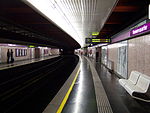Kunsthalle Wien
1992 establishments in Austria20th-century architecture in AustriaArt galleries established in 1992Art museums and galleries in ViennaBuildings and structures in Neubau

Kunsthalle Wien is the city of Vienna's institution for international contemporary art and discourse with two locations, in the Museumsquartier and at Karlsplatz. Kunsthalle Wien does not have a collection of its own, but instead dedicates its changing solo and thematic exhibitions to art and its relations to social change. It produces exhibitions, researches art practices, and supports local and international artists. It seeks to ground its knowledge of international contemporary art in and for Vienna, and advocates for the usefulness of artistic thinking in the wider public sphere.
Excerpt from the Wikipedia article Kunsthalle Wien (License: CC BY-SA 3.0, Authors, Images).Kunsthalle Wien
Siebensterngasse, Vienna Spittelberg (Neubau)
Geographical coordinates (GPS) Address Website Nearby Places Show on map
Geographical coordinates (GPS)
| Latitude | Longitude |
|---|---|
| N 48.203333333333 ° | E 16.359166666667 ° |
Address
MuseumsQuartier (Museumsquartier)
Siebensterngasse
1070 Vienna, Spittelberg (Neubau)
Austria
Open on Google Maps










